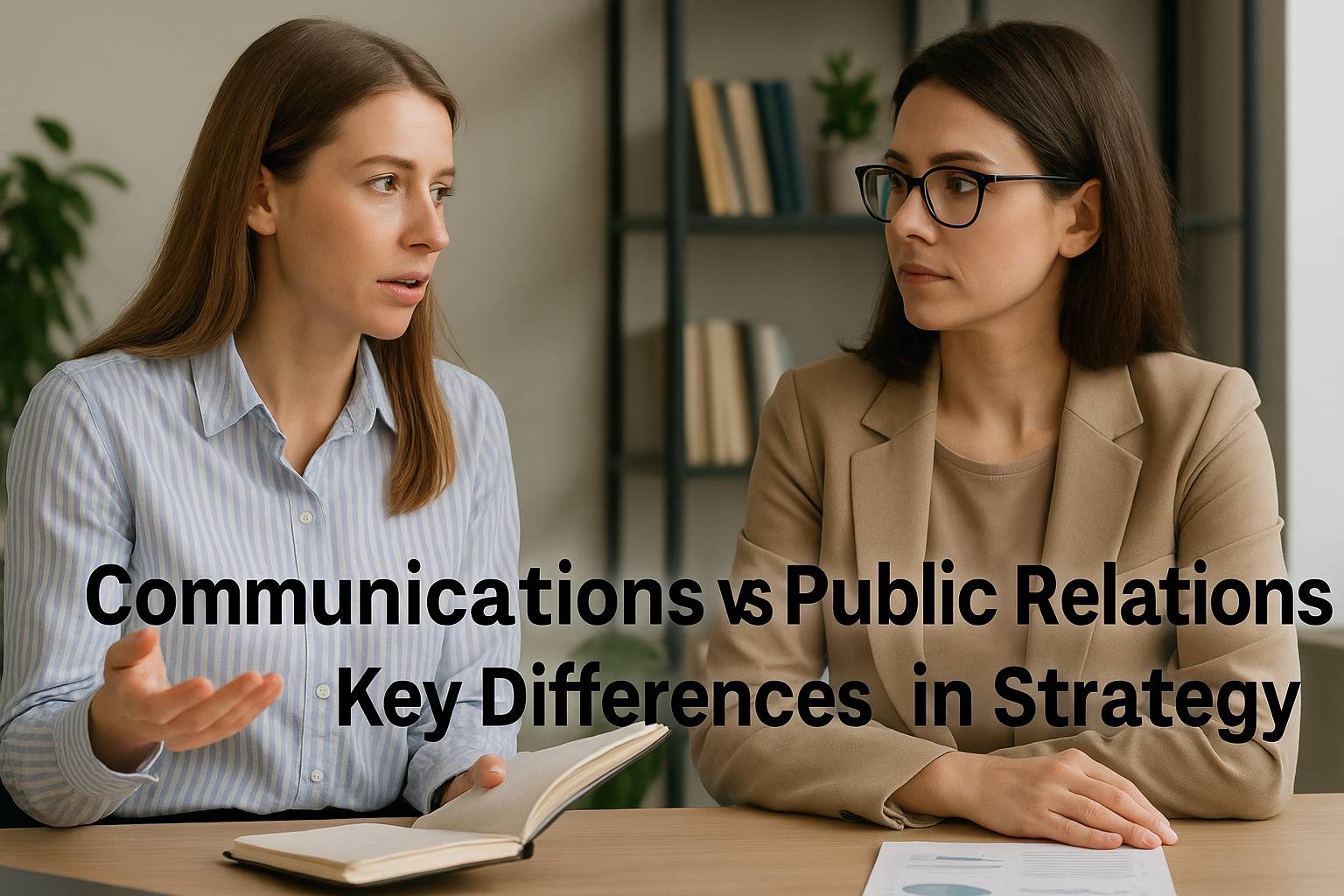
Amanda White
July 13, 2025
No Comments
Defining Communications vs Public Relations in the Corporate Landscape
The debate around “communications vs public relations” is more than just semantics—it reflects substantial differences in approach, objectives, and audiences. While often used interchangeably, communications and public relations serve distinct roles within corporate ecosystems.
Corporate communication encompasses a broad range of internal and external messaging. This includes everything from executive speechwriting and investor communications to internal newsletters and branding. Public relations, on the other hand, is more narrowly focused on managing a company’s reputation through earned media, press outreach, and crisis management.
In practice, these fields overlap, but they differ in emphasis. Communications professionals may focus on cohesive storytelling across departments and channels. PR professionals specialize in influencing public perception, often through third-party endorsements like media coverage.
This distinction becomes crucial when examining PR vs communication career paths. While both require writing and strategic thinking, the skills, tools, and metrics differ significantly. PR may require media pitching and crisis communication skills, while communications jobs often demand proficiency in internal platforms and cross-functional collaboration.
To see how messaging platforms intersect, check out What You Need to Know About Using All Marketing Communications Platforms.
Table of Contents
Strategic Messaging: Who You Speak To and How It Matters
In the ongoing comparison of “communications vs public relations,” strategic messaging provides a key lens. Communications tends to be more inward-looking, focused on internal stakeholders such as employees, investors, and partners. Public relations, conversely, is outward-facing, targeting journalists, influencers, and the general public.
These distinctions shape content formats and tone. Communications professionals may craft executive memos, HR updates, or training documents. PR practitioners create press releases, pitch decks, or social media strategies for public outreach.
Understanding the corporate messaging difference is vital here. Communicating internally requires clarity, alignment with corporate culture, and motivational tone. External messaging must be persuasive, often requiring narrative framing and reputation management tactics.
For those navigating a communications career path, this duality offers an opportunity to specialize or become versatile across roles. Adding skills like business English for PR helps professionals transition between internal and external responsibilities.
See 5 Reasons Internal Public Relations Drives Employee Engagement for examples of how internal messaging builds engagement.
Also, Learn English with online English teacher to refine professional language.
Key Career Differences Between PR and Communication Roles
To choose between communications and public relations, it’s essential to understand the career landscape. The core difference lies in purpose and metrics: PR is judged by media coverage, sentiment analysis, and public visibility, whereas corporate communications is measured by internal engagement, leadership alignment, and strategic clarity.
If you’re weighing a PR vs communication career, consider the industries that emphasize each. Tech firms, for instance, often prioritize communications for product updates and internal alignment. Consumer brands might lean heavily on PR for brand awareness and media coverage.
Both careers demand strategic thinking and creativity. However, PR professionals may need crisis communication training and media relationships. Communication specialists often collaborate with HR and leadership to manage internal narratives.
Educational paths also vary. PR roles benefit from journalism or media studies, while communications roles may require training in organizational development or business strategy. Regardless of path, fluency in business English for PR is an asset.
Explore Best Corporate Communications Jobs You Can Do Remotely to find flexible career options in either field.

Understanding the Corporate Messaging Difference
In organizations, messaging is never random—it’s deeply strategic. A key element of “communications vs public relations” is how messaging differs based on audience and purpose.
Communications departments focus on alignment. Their content includes company-wide emails, strategic updates, and branding guides. Their goal is to foster consistency and clarity, ensuring employees, investors, and partners all understand and support the brand’s direction.
Public relations teams, meanwhile, create messages designed to build trust with external stakeholders. They deal with press relations, product announcements, and thought leadership. Their messaging must adapt to different public contexts and media narratives.
This corporate messaging difference informs platform use. Communications may use intranet sites or Slack. PR professionals rely on media databases and press kits. Understanding this divergence can help students and early professionals decide which career suits their interests.
If you’re curious about communication roles, Why Corporate Communications Internships Offer Real Career Growth offers insights into hands-on experiences.
How Business English for PR Shapes Professional Credibility
Regardless of your focus in “communications vs public relations,” mastering business English for PR is critical. This form of English emphasizes precision, professionalism, and persuasion—skills needed in both fields but especially vital in external communication.
In PR, clear and compelling language is non-negotiable. Press releases, media pitches, and public statements must be sharp, factual, and impactful. Misused words or vague messaging can damage credibility.
Even in internal communications, tone and clarity matter. An executive email or town hall script written in weak English can mislead or demotivate employees.
For non-native speakers, professional fluency also affects upward mobility. Being able to confidently express strategy and respond to crises in English opens doors in global corporations. Programs focused on business English for PR train professionals in writing, speaking, and cultural nuances.
Grammar, tone, and cross-cultural messaging are part of this training—skills that help bridge the communications career path and PR opportunities.
See Communication or Communications Which One to Use in Business English for grammar tips relevant to messaging professionals.
Navigating the Communications Career Path in a Global Market
If you’re considering a career in corporate messaging, understanding the communications career path helps clarify your trajectory. Communications roles now span multiple departments—HR, marketing, investor relations, and C-suite advisory.
Entry-level positions may include content coordination, internal communications assistant, or marketing associate. Over time, professionals can move into roles such as communications strategist, director of internal messaging, or chief communications officer.
This career path is attractive for those who enjoy planning, writing, and working cross-functionally. It also offers stability, especially in global corporations that value alignment and clarity across regions.
Compared to PR, the communications track may involve fewer media crises but more structured planning and long-term impact. However, skills often overlap—especially in writing and strategic messaging.
Understanding this path helps clarify the broader conversation around “communications vs public relations.” And for students or career changers, remote roles make this field more accessible.
Browse Finding the Best Corporate Communication Jobs in 2025 and Beyond to discover future-proof opportunities.
Essential Strategic Messaging Jobs and Their Evolving Role
One outcome of the growing interest in “communications vs public relations” is the rise of strategic messaging jobs. These roles blur the lines between internal and external communication, emphasizing integrated messaging that aligns reputation with corporate goals.
Common job titles include:
Messaging Strategist
Corporate Storyteller
Brand Communications Lead
Head of Executive Communications
These jobs demand both tactical skills (copywriting, media outreach) and strategic insight (audience analysis, reputation management). Companies are investing in these roles because they recognize that every message—internal or external—shapes the brand.
Candidates who can balance communication clarity with brand influence are in high demand. And professionals fluent in business English for PR often lead in these hybrid roles.
To learn how you might build or transition into this field, Contact Us | CorporateEnglish.biz—we’ll help you find the right path based on your strengths and interests.
Latest Blog
More on Corporate Communication

Corporate Communications Job Description and
Corporate communications job description includes internal messaging, media handling, and strategic branding roles for



Why Corporate Communications Careers Are
Corporate communications careers are in high demand as companies seek better branding, messaging, and



Choosing the Best Corporate Communication
Corporate communication solutions include digital platforms and tools that streamline internal messages and improve







